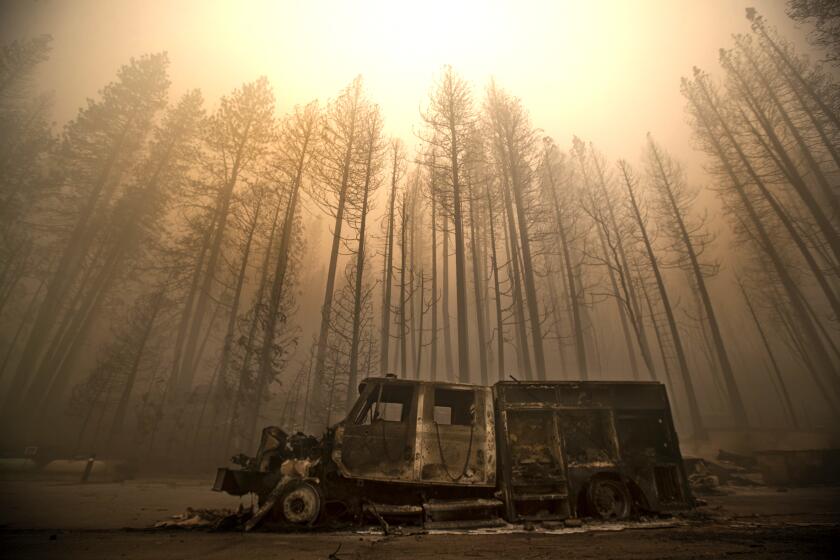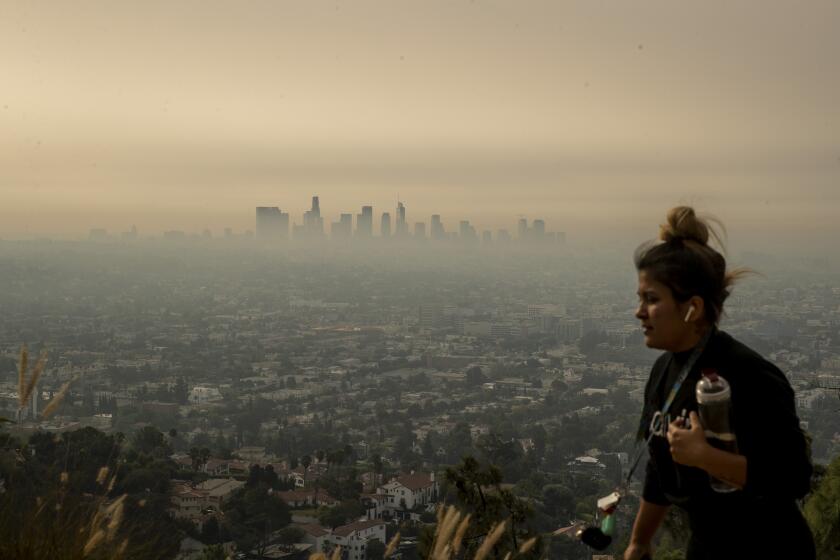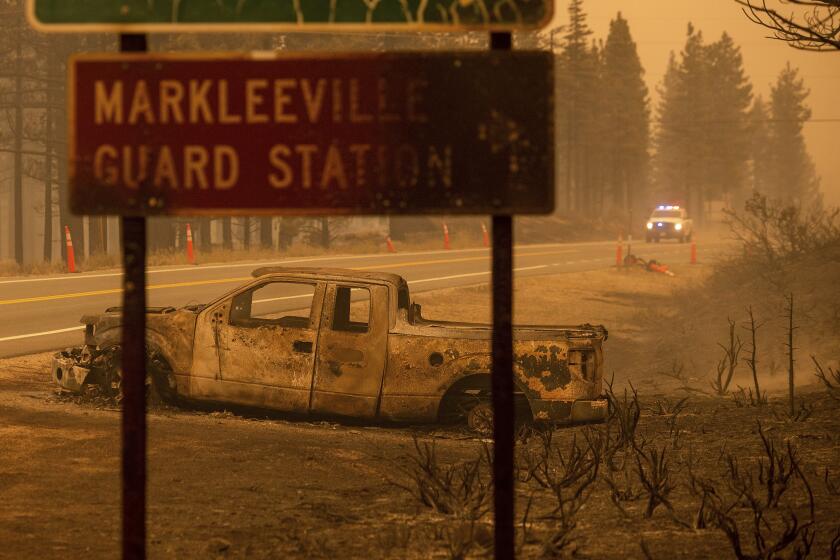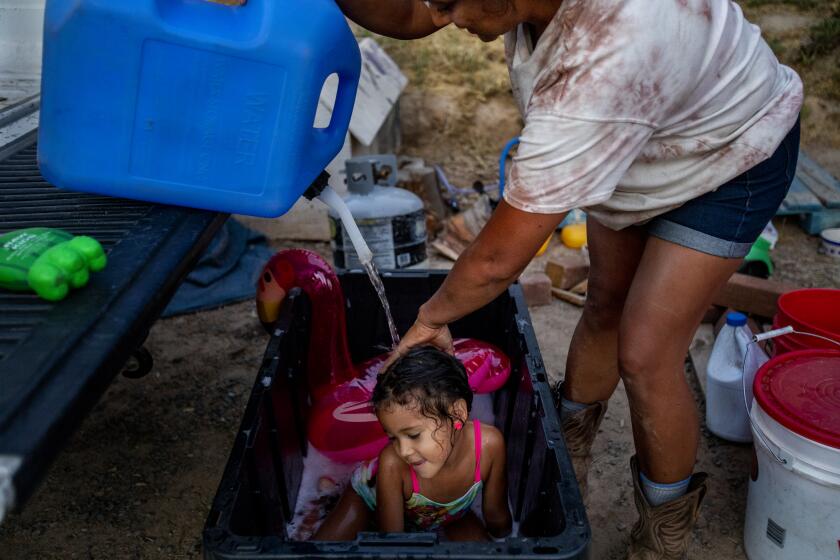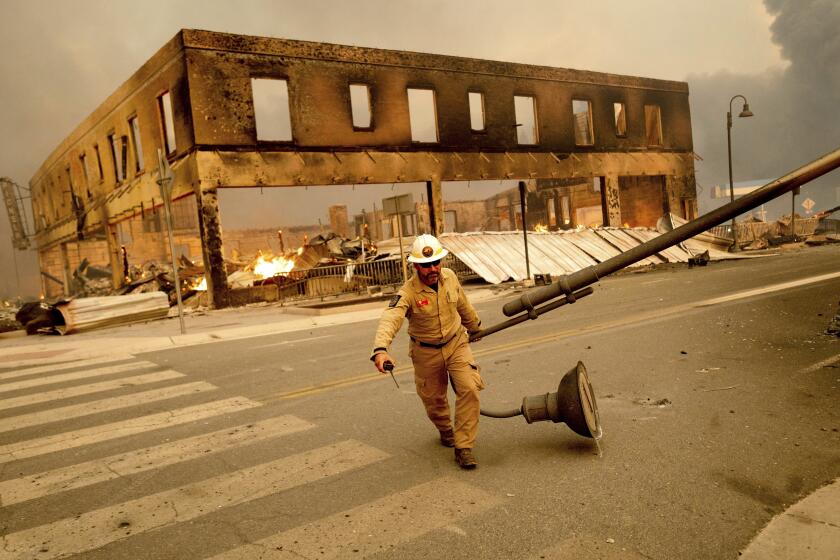California’s wildfire season is here. How to get ready
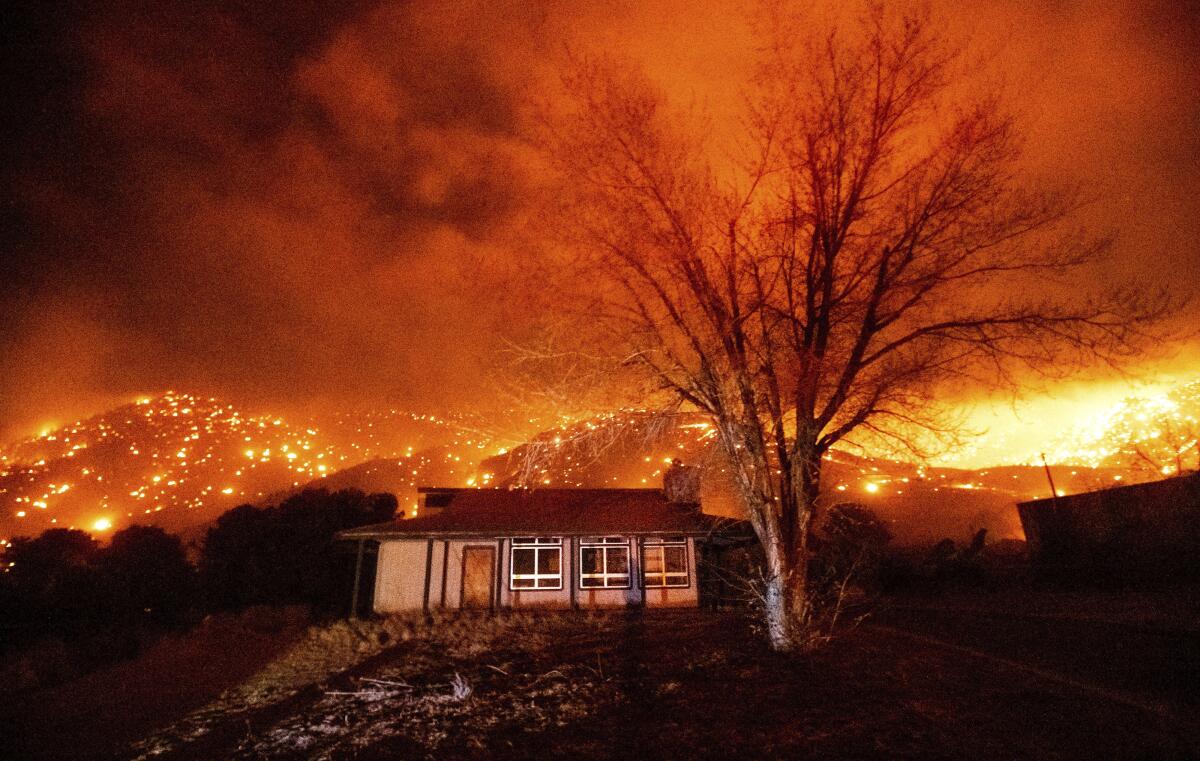
- Share via
The Great Plains have tornadoes. The Southeast has hurricanes. And California has earthquakes and wildfires.
More than 4 million acres were burned last year in what was the state’s worst wildfire season to date. So far in 2021, Northern California has faced the brunt of wildfires. But Southern California is approaching the time of year when Santa Ana winds can drive fires.
Drought, climate change and more people moving into areas prone to wildfire are things that Los Angeles Fire Department public information officer Erik Scott said are going to contribute to a challenging 2021 fire season.
Early in the week, the Dixie fire continued to grow and the River fire burned homes north of Sacramento.
Here are some things Southern Californians should do now, well before you smell smoke or see flames.
“Preparation is really the name of the game,” Angeles National Forest Fire Chief Robert Garcia said.
Before a wildfire
Finances: Make sure your fire insurance policy is up to date, said Michele Steinberg, wildfire division director for the National Fire Protection Assn. Documenting items in your home with your cellphone camera is a great way to keep track of your valuables in case you have to make a claim. Also check to see what your policy covers in case you have to be out of your home for a while. Some policies cover hotel stays.
Keeping cash in small bills on hand can help you avoid trouble if the power grid goes down and you’re unable to use ATMs or credit cards, said Barbara Mariscal, senior disaster program manager for the American Red Cross Los Angeles Region.
Get earthquake-ready in six weeks
From building a kit to buying insurance, our Unshaken newsletter course will help you prepare.
You may occasionally receive promotional content from the Los Angeles Times.
Copies of important documents, including your lease agreement and insurance policy, should be kept in your emergency supplies. Other documents, such as your ID and medical insurance information, should also be near at hand.
Go bag: Supplies should be checked and rotated every year, Mariscal said. Similar to what you should have on hand for an earthquake, a go bag for wildfires should have enough supplies to last each member of your household three to five days.
Food, water, clothing, medications and comfort items should be ready when it comes time to evacuate. Wildfire-specific items to have in your go bag include an N-95 mask, long pants and long-sleeved shirts. The N-95 mask offers the best protection from smoke, Mariscal said; other masks worn to protect against COVID-19 are not as effective. Long, protective clothing will help keep your skin safe if you encounter embers from a fire.
Action plan: Having a plan A, B and C for how to get out of the area if you’re ordered to evacuate is crucial, Mariscal said. Routes you’d normally take may be blocked by emergency responders or the fire itself. A rehearsed and memorized evacuation plan can help ensure your and your family’s safety.
Emergency contacts and designated meeting spots outside of the fire area should be established beforehand. That way, everyone knows where to go and whom to call once they’re out of immediate danger.
Find out where your emergency evacuation sites will be by following local authorities on social media, dialing 211 or bookmarking the county’s website. Last year, Mariscal said, people were sent to hotels because of worries about COVID-19. This year, the Red Cross anticipates that group evacuation sites will be back, but with masking and distancing.
Action plans should account for work and school schedules. Find out what your child’s school plan is, and take that into consideration. Also consider your commute. It’s always a good idea to have extra supplies in your car, but if your drive is long or you work in a wildfire-prone area, you may want to pack some extra supplies in case you get caught in the middle of a wildfire.
If air purifiers are sold out or out of your budget, a simple air filter taped to a box fan can filter harmful particulate matter and keep it out of your lungs and bloodstream. Here’s what you need to know.
At home: Think of your home as having three zones around it, each of which can be modified to reduce the danger from an approaching wildfire.
The first zone includes anything within 5 feet of a structure. Things to avoid in this area include vegetation and wood, such as an untreated deck or pile of firewood. The second zone is between 5 and 30 feet from a structure. Tall trees should be kept at least 10 feet from your structures, and ground coverings should be maintained. Follow local regulations and recommendations on brush clearing. Mariscal said to contact your local fire authority to learn more. The third zone reaches up to 100 feet away from your structure. Vegetation should be spaced out and well maintained.
For more detail, check out the L.A. Times’ guide to fireproofing your home.
Like retrofitting your home for an earthquake, small and large changes can increase your home’s resilience. Low-cost renovations such as covering any openings on your roof or installing non-combustible gutter covers can ensure that falling embers don’t have anything to ignite.
Multi-paned windows and weather stripping around doorways can help to keep smoke and ash out of your home. Windows with at least one pane of tempered glass are also less likely to shatter under high-heat conditions.
Keeping rain gutters clear of debris will also help.
Experts say air purifiers can be helpful in combatting the spread of COVID-19, as well as other harmful particles filling the air from wildfires.
During a wildfire
On average, you have only two minutes to get out of your home after being ordered to evacuate, Mariscal said.
Fast-moving Santa Ana winds can quickly change the course of a wildfire.
“We would love to park a fire engine in every driveway, and it’s just not possible,” Scott said. “So the public needs to be prepared.”
There is a difference between an evacuation warning and an evacuation order, Mariscal said. If a warning is issued, get ready. If an order is issued, go.
Evacuation orders, Scott said, are informed by previous fire data, current temperature, wind direction and other factors. They don’t come lightly, and they are issued with purpose.
For Angelenos, there are a few ways you can receive evacuation warnings and orders.
- The Red Cross emergency alert app lets you track information on severe weather and hazards in areas where you and your loved ones live. Like its earthquake counterpart, this app also has supplemental information on how to prepare for a wildfire and locations of Red Cross shelters.
- Alert L.A. County: Register your phone number or email to receive alerts on emergencies or disasters across the county from the Sheriff’s Department. This system is used to issue shelter-in-place and evacuation messages. This resource is adaptable for disabilities and available in multiple languages. Register on the county’s website.
- Notify L.A.: Receive messages regarding public health notices, evacuation orders and early warnings for the city of Los Angeles through phone, email and text message. Register on the city’s website.
- Nixle: Register to receive texts and phone calls from local law enforcement agencies for specific areas throughout L.A. County.
- Follow local authorities and news sources on social media to stay updated, Mariscal recommended.
Whether you’re the most prepared person in L.A. or you haven’t prepared at all — remember the six P’s when it comes time to evacuate.
- People and pets: Ensure all the members of your household, including children, the elderly and disabled, are safely out of the home. This also includes the furry, feathered and finned members of your household. For more on pet safety, check out how to prepare your pet for an earthquake.
- Papers, phone numbers and important documents: Copies of all these things should already be in your go bag, but if they aren’t — or if you have the chance to grab the originals, make sure you grab things like your lease agreement, medical insurance card and a list of emergency contacts.
- Prescriptions, vitamins and eyeglasses: A three- to five-day supply of medications should already be set aside in case of an emergency — if you can. Glasses should be kept where they can be easily accessed or an extra pair should be stored in your go bag.
- Pictures and irreplaceable memorabilia: Your first instinct may be to go for precious memories, and that’s OK. Be conscious of how you are storing or displaying these items. Don’t want to lose those photos of grandma? Keep them in an album or manila envelope that can be easily grabbed.
- Personal computers and hard drives: Be sure to regularly back up important data onto an external hard drive or to the cloud. And keep a protective case for carrying your laptop.
- Plastic (credit cards, ATM cards) and cash: After ordering pizza you may want to toss your card onto the dining room table. Don’t. Keep your sources of payment together in your wallet, and make sure that wallet is easily accessible when it comes time to evacuate.
The U.S. Forest Service indicates it will be more aggressive in putting out blazes early rather than letting some burn as a way to thin out brush.
Evacuation do’s and don’ts
In high-stress situations, it’s easy to make mistakes. Steinberg said there are some things you should do if you have time — and some things you definitely shouldn’t.
Do: If you’re able to steal a few extra moments, she said, make sure your windows, pet doors and the fireplace grate are closed.
Do: Moving flammable furniture like curtains and couches away from the windows and turning off the gas in your house, according to Cal Fire, are other things that you can do if you have time.
Don’t: One thing you shouldn’t do is try to fight a fire yourself. Images of people pulling out their garden hose and wetting down their homes may look heroic, but the LAFD’s Scott said that “a small garden hose is not going to make the difference of your home burning or not.”
When it comes to fighting wildfires, leave it to the pros.
“You provide the defense, we will provide the offense,” Scott said.
Thousands of people displaced by the Camp fire in 2018 are still stuck in limbo, many camping on their own land and fearing eviction.
After a wildfire
Once the danger has passed, get ready to assess any damage.
Watching flames engulf large swaths of the state on TV isn’t easy, especially if your home is in the fire’s path. But Steinberg urges you to be patient.
Authorities will give the all clear for you to return home once it’s safe and the threat of fire is no longer imminent. Stay updated on current conditions using social media and through your area’s alert systems.
Do a home assessment: Some residents may be returning to an unscathed home, while others may have to sort through rubble and ash. No matter the state of your home, document it. Take photos, videos and notes. “If you don’t document it, there’s no proof,” Mariscal said. Documentation is key to filing an insurance claim successfully, and in some cases, receiving federal and state aid.
Be aware of hazards: Although the wildfire may have passed, smoke, ash, damage and power loss all present hazards to your health and safety. Learn how to properly remove ash from your roof and gutters so it doesn’t get circulated through your house by air conditioners. Installing or making your own air filter can also help keep smoke from irritating your lungs.
Damaged gas lines require immediate attention. Call your gas company.
Power loss is common during wildfires. Steinberg recommends disposing of all the perishable food in your fridge if you’ve been out of the home for any period of time and had power loss.
The destruction by the Dixie fire of a large swath of the Gold Rush town of Greenville left residents stunned and mourning all that has been lost.
More information
It’s important to remember that no matter how fancy your go bag is or how well-manicured the vegetation is outside your home, there’s only so much you can do.
“For the rest of your life, you’re going to feel like you could have done more, but at least you’ve done more than nothing,” Steinberg said.
Here are some websites with more information on wildfire preparedness:
More to Read
Sign up for Essential California
The most important California stories and recommendations in your inbox every morning.
You may occasionally receive promotional content from the Los Angeles Times.
